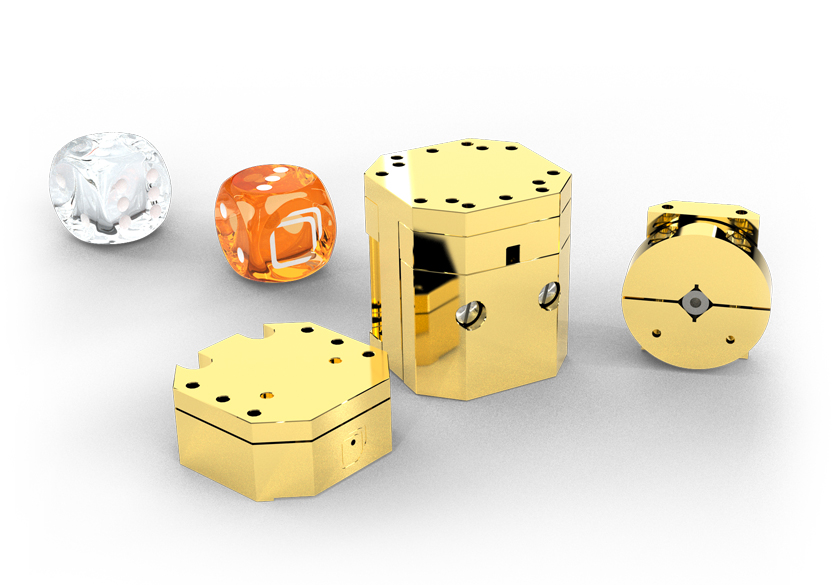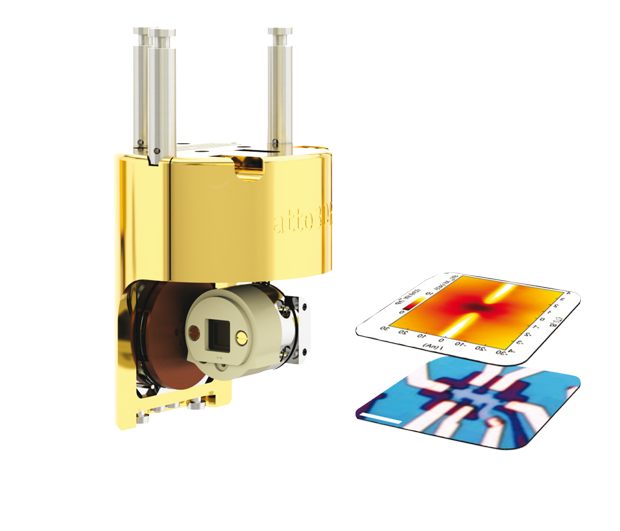
mK Nanopositioners
linear positioners, goniometers, rotators & scanners
broad portfolio offers experimental flexibility
linear positioners, rotators, goniometers, and scanners
made from beryllium copper
non-magnetic with enhanced thermal conductivity
/RES+ sensor for readout
enables reliable position readout below 1 K
Many experiments require nanoprecise motion of samples or probe heads also at mK temperatures. Apart from SPM, based on linearpositioners and scanners, such applications would be rotation of
mesoscopic samples in magnetic fields, either by 1D or 2D rotators, or using goniometers to tilt samples with respect to, e.g. optical elements. Also, optical fiber probes may have to be positioned in situ relative to planar waveguides for investigating photonic circuits such as cavities coupled to superconductors. Entering the ultra-low temperature regime requires a careful choice of materials and used components. Not only thermal expansion has to be taken into account, but also phase transitions of materials that effect, e.g., thermal conductivity or magnetic properties.
Since titanium - the standard non-magnetic material used for cryogenic nanopositioners - becomes superconducting at about 400 mK, attocube offers linear positioners, rotators and scanners made of beryllium copper.
For better thermal conduction at interfaces, thermal links and sample holders are usually Au plated. Last but not least, the dedicated '/ULT' positioners are equipped with a special resistive sensor (/RES+). These sensors allow for a reliable readout of absolute position also at temperatures below 1 K.

mK atto3DR
double rotator module
in-situ eucentric two-axes sample rotation
turn single solenoid into strong 3D vector magnet
chip carrier socket with non-magnetic pogo pins
quick sample exchange with reliable contacts
resistive encoders for closed-loop operation
program complex rotation schemes
When investigating magnetically anisotropic and low-dimensional samples, researchers not only want to vary the magnetic field strength, but also the field direction with respect to the sample. The atto3DR features two piezo-based rotators, which allow for rotation around a horizontally fixed axis, and an additional in-plane axis. This enables a ±90° tilt between sample surface and field, as well as another ±90° of in-plane rotation. Thus, any relative orientation between sample and field is accessible with a single solenoid and a bipolar magnet powersupply via this eucentric rotation (with both rotator axes intersecting in the field center). Since split coil magnets are limited to a few Tesla in field strength (e.g. 9-1-1 T or 5-2-2 T) this makes available a much larger phase space as compared to conventional vector magnets, where the field vector is rotated instead. A 12 T single solenoid hence suddenly offers the full 12 T in 3 dimensions when combined with the atto3DR.
The module comes fully wired and equipped with a convenient leadless ceramic chip carrier (LCCC) socket with 20 contacts, making sample exchange a quick and easy task. The module can be made compatible with almost any dilution refrigerator provided that the sample space diameter is large enough (typically 50 mm; customizations on request). The achievable base temperature of the sample, as well as the thermal anchoring of the rotators to ensure efficient heat transport of the dissipated energy during rotation, depends on the cryostat used. For typical results, please contact
attocube.

